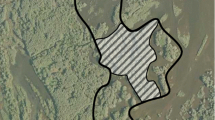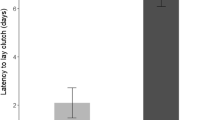Abstract
Growth and survival of altricial young are influenced by their parents’ abilities to invest in a breeding attempt. As a result, chick growth and survival in one breeding season may be indicative of their parents’ long-term reproductive potential. To determine whether variation in long-term reproductive success is driven by differential breeding investment, parental care and chick growth in wandering albatrosses (Diomedea exulans) were correlated with parental historical reproductive success. Effects of age and breeding experience (determined from past breeding attempts) and pre-laying body condition (mass–size indices) on chick growth and survival also were tested. Longer brooding of chicks increased their survival, but length of chick brooding did not differ between historically unproductive and successful breeders. Past reproductive success also was not correlated with chick growth rates or fledging mass or size. Chick brooding period, chick growth rates, final mass and size were independent of parental body condition. Older and more experienced parents brooded chicks for longer and their chicks grew faster, supporting previous findings that breeding competence is a learnt skill. Chick care and growth characteristics differed more between than within pairs, suggesting that differences in these characteristics are driven by variation among pairs.




Similar content being viewed by others
References
Amat JA, Visser GH, Pérez-Hurtado A, Arroyo GM (2000) Brood desertion by female shorebirds: a test of the differential parental capacity hypothesis on Kentish plovers. Proc R Soc Lond B 267:2171–2176
Bell MBV (2010) Sex and age influence responses to changes in the cost of cooperative care in a social carnivore. Behav Ecol 21:1118–1123
Benton TG, St Clair JJH, Plaistow SJ (2008) Maternal effects mediated by maternal age: from life histories to population dynamics. J Anim Ecol 77:1038–1046
Berrow SD, Humpidge R, Croxall JP (2000) Influence of adult breeding experience on growth and provisioning of wandering albatross Diomedea exulans chicks at South Georgia. Ibis 142:199–207
Brown ME (1996) Assessing body condition in birds. Curr Ornithol 13:67–135
Brown CR, Adams NJ (1984) Female wandering albatross Diomedea exulans raising a chick on its own at Marion Island. Cormorant 12:103–104
Catry P, Phillips RA, Forcada J, Croxall JP (2010a) Factors affecting the solution of a parental dilemma in albatrosses: at what age should chicks be left unattended? Anim Behav 72:383–391
Catry P, Phillips RA, Forster IP, Matias R, Lecoq M, Granadeiro JP, Strange IJ (2010b) Brood-guarding duration in black-browed albatrosses Thalassarche melanophris: temporal, geographical and individual variation. J Avian Biol 41:460–469
Chevan A, Sutherland M (1991) Hierarchical partitioning. Am Stat 45:90–96
Clutton-Brock TH (1991) The evolution of parental care. Princeton University Press, Princeton
Crawley MJ (2008) The R book. Wiley, Chichester
Croxall JP (1990) Constraints on reproduction in albatrosses. ACTA XX Congressus Internationalis Ornithologici, Christchurch, pp 279–302
Croxall JP, Ricketts C (1983) Energy costs of incubation in the wandering albatross Diomedea exulans. Ibis 125:33–39
Dilley BJ, Davies D, Connan M, Cooper J, de Villiers M, Swart L, Vandenabeele S, Ropert-Coudert Y, Ryan PG (2013) Giant petrels as predators of albatross chicks. Polar Biol 36:761–766
Fressanges du Bost D, Segonzac M (1976) Note complementaire sur le cycle reproducteur du grand albatros (Diomedea exulans) de l’isle de la Possession, archipel Crozet. Com Nat Franç Rech Ant 40:53–60
Fridolfsson A-K, Ellegren H (1999) A simple and universal method for molecular sexing of non-ratite birds. J Avian Biol 30:116–121
Froy H, Phillips RA, Wood AG, Nussey DH, Lewis S (2013) Age-related variation in reproductive traits in the wandering albatross: evidence for terminal improvement following senescence. Ecol Lett 16:642–649
Gardner A, Smiseth PT (2010) Evolution of parental care driven by mutual reinforcement of parental food provisioning and sibling competition. Proc R Soc Lond B 278:196–203
Gebhardt-Henrich S, Richner H (1998) Causes of growth and variation and its consequences for fitness. In: Starck JM, Ricklefs RE (eds) Avian growth and development. Oxford University Press, Oxford, pp 324–339
Gibson JD (1967) The wandering albatross (Diomedea exulans): results of banding and observations in New South Wales coastal waters and the Tasman Sea. Notornis 14:47–57
Green AJ (2001) Mass/length residuals: measures of body condition or generations of spurious results? Ecology 82:1473–1483
Gubernick DJ, Klopfer PH (1981) Parental care in mammals. Plenum Publishing Corporation, New York
Hayes JP, Shonkwiler JS (2001) Morphological indicators of body condition: useful or wishful thinking? In: Speakman JR (ed) Body composition analysis of animals: a handbook of non-destructive methods. Cambridge University Press, Cambridge, pp 8–38
Højsgaard S, Halekoh U, Yan J (2005) The R package geepack for generalized estimating equations. J Stat Softw 15:1–11
Jones MGW (2011) Individual variation in reproductive success in the wandering albatross. Ph.D. Thesis, Percy FitzPatrick Institute of African Ornithology, University of Cape Town, South Africa 129
Jones MGW, Ryan PG (2013) Effects of pre-laying attendance and body condition on long-term reproductive success in wandering albatrosses. Emu http://dx.doi.org/10.1071/MU12054
Jones MGW, Techow NMSM, Ryan PG (2012) Dalliances and doubtful dads: what determines extra-pair paternity in socially monogamous wandering albatrosses? Behav Ecol Sociobiol. doi:10.1007/s00265-012-1374-8
Jouventin P, Lequette B, Dobson S (1999) Age-related mate choice in the wandering albatross. Anim Behav 57:1099–1106
Koskela E, Juutistenaho P, Mappes T, Oksanen TA (2000) Offspring defence in relation to litter size and age: experiment in the bank vole Clethrionomys glareolus. Evol Ecol 14:99–109
Lavery RJ, Kieffer JD (1994) Effects of parent and offspring food rations on parental care in the convict cichlid fish (Pisces, Cichlidae). Behaviour 129:63–77
Lecomte VJ, Sorci G, Cornet S, Jaeger A, Faivre B, Arnoux E, Gaillard M, Trouvé C, Besson D, Chastel O, Weimerskirch H (2010) Patterns of aging in the long-lived wandering albatross. Proc Natl Acad Sci USA 107:6370–6375
Lequette B, Weimerskirch H (1990) Influence of parental experience on the growth of wandering albatross chicks. Condor 92:726–731
Lewis S, Hamer KC, Money L, Griffiths R, Wanless S, Sherratt TN (2004) Brood neglect and contingent foraging behavior in a pelagic seabird. Behav Ecol Sociobiol 56:81–88
Lewis S, Wanless S, Elston DA, Schultz MD, Mackley E, Du Toit M, Underhill JG, Harris MP (2006) Determinants of quality in a long-lived colonial species. J Anim Ecol 75:1304–1312
Møller P, de Lope F, Saino N (2005) Reproduction and migration in relation to senescence in the barn swallow Hirundo rustica: a study of avian ‘centenarians’. Age 27:307–318
Moreno J (2003) Lifetime reproductive success in seabirds: interindividual differences and implications for conservation. Sci Mar 67:7–12
Newton I (1989) Lifetime reproduction in birds. Academic Press, London
O’Dwyer TW, Buttemer WA, Priddel DM (2007) Differential rates of offspring provisioning in Gould’s petrels: are better feeders better breeders? Aust J Zool 55:155–160
Prince PA, Ricketts C (1981) Relationships between food supply and growth in albatrosses: an interspecific chick fostering experiment. Ornis Scand 12:207–210
R Development Core Team (2010) R: a language and environment for statistical computing. R Foundation for Statistical Computing. Vienna, Austria. www.R-project.org
Richards FJ (1959) A flexible growth function for empirical use. J Exp Bot 10:290–300
Ricketts C, Prince PA (1981) Comparison of growth of albatrosses. Ornis Scand 12:120–124
Ricklefs RE (1968) Patterns of growth in birds. Ibis 110:419–451
Ricklefs RE (1973) Patterns of growth in birds. II. Growth rate and mode of development. Ibis 115:177–210
Schulte-Hostedde AI, Zinner B, Millar JS, Hickling GJ (2005) Restitution of mass–size residuals: validating body condition indices. Ecology 86:155–163
Shaffer SA, Weimerskirch H, Costa DP (2001) Functional significance of sexual dimorphism in wandering albatrosses, Diomedea exulans. Funct Ecol 15:2203–2210
Stearns SC (1992) The evolution of life histories. Oxford University Press, Oxford
Takahashi A, Niizuma Y, Watanuki Y (1999) Regulation of food provisioning and parental body condition in Leach’s stormpetrels, Oceanodroma leucorhoa: experimental manipulation of offspring food demand. Ecol Res 14:155–164
Tickell WLN (1968) Biology of the great albatrosses, Diomedea exulans and Diomedea epomophora. Antarct Res Ser 12:1–55
Tickell WLN (2000) Albatrosses. Pica Press, Sussex
van Noordwijk AJ, Marks HL (1998) Genetic aspects of growth. In: Starck JM, Ricklefs RE (eds) Avian growth and development. Oxford University Press, Oxford, pp 305–323
Walsh C, Mac Nally R (2008) hier.part hierarchical partitioning. R package version 1.0-3.12
Weimerskirch H (1990) The influence of age and experience on breeding performance of the Antarctic fulmar, Fulmarus glacialoides. J Anim Ecol 59:867–875
Weimerskirch H (1992) Reproductive effort in long-lived birds: age-specific patterns of condition, reproduction and survival in the wandering albatross. Oikos 64:464–473
Weimerskirch H, Barbraud C, Lys P (2000) Sex differences in parental investment and chick growth in wandering albatross: fitness consequences. Ecology 81:309–318
Wendeln H, Becker PH (1999) Effects of parental quality and effort in the reproduction of common terns. J Anim Ecol 68:205–214
Yan J (2002) geepack: yet another package for generalized estimating equations. R-News 2(3):12–14
Yan J, Fine JP (2004) Estimating equations for association structures. Stat Med 23:859–880
Zach R (1988) Growth-curve analysis: a critical reevaluation. Auk 105:208–210
Zuur AF, Ieno EN, Walker N, Saveliev AA, Smith GM (2009) Mixed effects models and extensions in ecology with R. Springer, Berlin
Acknowledgments
Thanks to members of four Marion Expeditions (M63–M66) for assistance with weighing chicks. Long-term monitoring of wandering albatrosses at Marion Island was initiated by John Cooper. Genetic sexing was performed by Mareile Techow and the DNA Sequencing Unit, Central Analytical Facility, Stellenbosch University. We also thank two anonymous reviewers for their constructive comments on the manuscript. Financial and logistical support was provided by the DST/NRF Centre of Excellence (CoE) at the Percy FitzPatrick Institute of African Ornithology and the South African National Antarctic Programme (through the National Research Foundation).
Author information
Authors and Affiliations
Corresponding author
Electronic supplementary material
Below is the link to the electronic supplementary material.
Rights and permissions
About this article
Cite this article
Jones, M.G.W., Dilley, B.J., Hagens, Q.A. et al. The effect of parental age, experience and historical reproductive success on wandering albatross (Diomedea exulans) chick growth and survival. Polar Biol 37, 1633–1644 (2014). https://doi.org/10.1007/s00300-014-1550-6
Received:
Revised:
Accepted:
Published:
Issue Date:
DOI: https://doi.org/10.1007/s00300-014-1550-6




